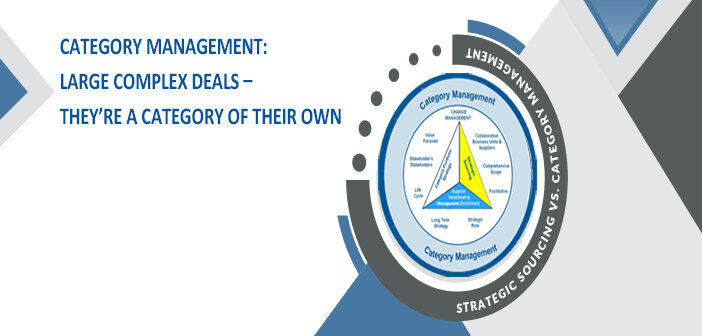Large Complex Deals (LCDs) may not have a unique definition but they do have a set of unique characteristics which makes them a bit easier to study and learn from. They don’t have a unique definition because what’s large or complex for one may not be for another. They could be outsourcing deals, large projects (technology etc.), outcome-based transactions etc. But here are some things that they do share:
- Large or Complex Transaction
- Broad Scope – (Numerous if not ALL Business Units Involved)
- Many Stakeholders with varied Value Drivers
- Decision Making that goes beyond organizational silos
- Requirements Definition is Critical
- HUGE Business Impact
- Risk must be factored into Total Cost of Ownership Model
- Requires careful planning to maximize Value
And as always, Adoption of the solution is key to achieving the Stakeholder Value Drivers (SVDs). The other major difference is that the decision-making shifts from a focus on costs to many other SVDs like Operational Advantage, Risk Management, Operational Growth, Innovation, New Product Growth and your Stakeholder’s Stakeholder Value Drivers. This is why Requirements Definition is identified as critical above. The ability (depends on their Strategic Competencies 😊) of your team to unearth these SVDs of both Primary and Secondary Stakeholders becomes critical. Here is a list of critical decision components from Gartner for IT LCDs:
- Enable E business strategy
- Align IT/Business Goals
- Close critical competency gaps
- Gain process knowledge
- Migrate to new technology
- Reduce capital costs
- Reduce transaction costs
- Improve service levels
- Focus on core business
You will notice that costs are only a part of the SVDs and decision factors. The question you need to answer is can your team unearth these from your Stakeholders and then use them as decision variables in your Category Management strategies and sourcing events?
Because LCDs share common characteristics, there are also some common reasons why they fail which means that these reasons are Predictable and Inevitable and therefore you can and should plan for them. These should be part of your launch strategy for these initiatives:
- Lack of Oversight
- Unclear Goals/Objectives
- No formal decision-making process
- Changing Objectives
- Lack of Risk Mitigation
- Lack of Project Governance
- Inappropriate skills
- Lack of communication
- Unrealistic time/resource estimates
And if you didn’t notice, ALL of these are internal and require Change Management (Strategic Competencies). And this is why, in addition to doing all the robust market analysis and supplier feasibility studies, there must be equally robust and tough questions to ask internally. Here are some examples related to outsourcing:
- Is leadership prepared to make difficult decisions?
- Can we manage quality of the function when outsourced?
- Is the organization prepared to focus on its core competencies?
- Can the function be restructured without putting core competencies at risk?
- What are our competitive advantages?
- How can we better support core competencies?
- Where is our hidden value?
We have been involved in our share of many, many LCDs. These have involved outsourcing, offshoring, global, over $100M, competitors cooperating in sourcing etc. etc. And the one thing that we have learnt is that the relationship after the deal is signed has far more to do with successful outcomes than everything else combined. Unfortunately, most of the energy is spent on negotiating the deal and not establishing the relationship between all the parties. Here are some things to keep in mind:
- Relationships between customers and suppliers are key to the success of these
- Relationship maps and ongoing assessments will support this
- Active Relationship Optimization on both sides is required
- Consistent management of the relationship is required
- Successful Category Managers ensure strong and collaborative relationships with their suppliers
- Supported by performance metrics and end-user satisfaction measures
- Implement process and metric improvements during launch and throughout the relationship
Category Managers ensure that Supplier Value Drivers are also met throughout the relationship. And yes, therefore Strategic Competencies are critical 😊!!!

